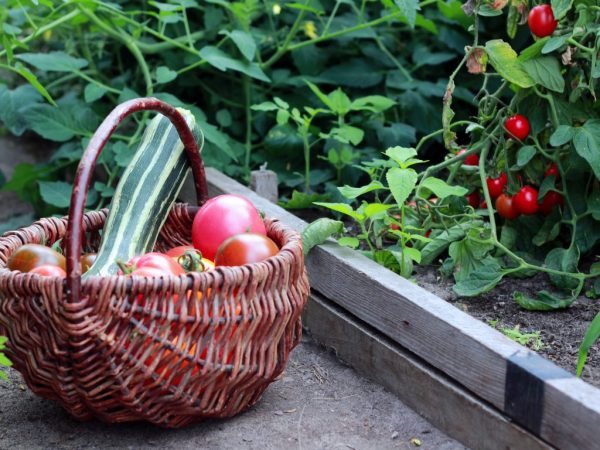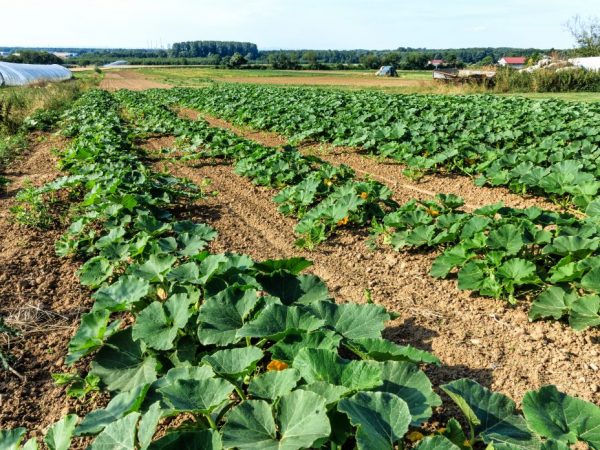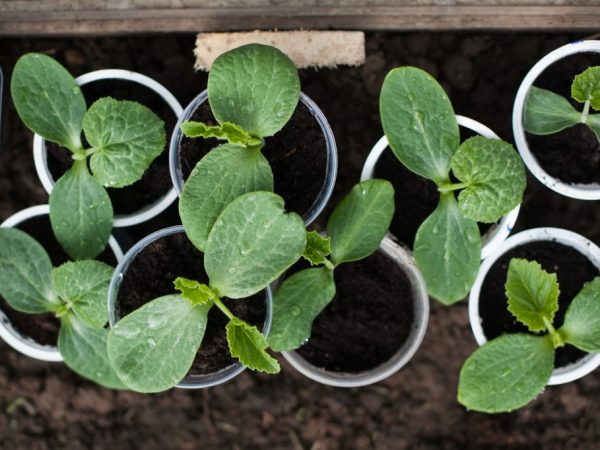Zucchini compatibility with other crops
Cultivating zucchini, gardeners think over everything to the smallest detail, which allows you to get a good harvest of delicious vegetables. This requires knowing what are the best neighbors for a vegetable marrow. This culture does not tolerate the neighborhood with some plants, from this it grows poorly and bears fruit.

Zucchini compatibility with other crops
Plant relationships
Planting a liana-like culture is not allowed with all plants, because a constantly growing bush is able to destroy other plantings:
- It is undesirable to have a zucchini next to tomatoes, since both crops have poor compatibility. Some gardeners are experimenting and claim that it is worth planting zucchini with tomatoes. Growing on the same bed with tomatoes, the pumpkin crop will be protected from harmful insects - aphids, moths and sawflies.
- Zucchini and cucumbers are not the best neighbors, because both crops are pome crops and are frequently cross-pollinated. When planted together, cucumbers with zucchini will give a meager and low-quality crop.
- Zucchini is allowed to be planted in a row with squash and pumpkin. This is a pretty good combination of plants as they are cared for in the same way, which makes growing easier. When planting zucchini next to squash and pumpkin, it is necessary to take into account some disadvantages: these plants suffer from the same diseases, growing them in the same garden, a person should regularly inspect for infection, quickly take measures so as not to lose all vegetation as a result. The second unfavorable moment is that in zucchini, pumpkin and squash, which belong to the same family, as well as in zucchini with cucumbers, cross-pollination can occur, which will negatively affect the yield.
- Cabbage can be a neighboring zucchini, if there is a lot of space on the site and the zucchini will not drown out young and fragile seedlings.
- The neighborhood of zucchini with onions will be successful. Fragrant greenery protects the planting from the invasion of various parasites, the yield of both crops when planted together is good.
You can not plant zucchini with melons that belong to the same family. These plants need the same nutrients, suffer from the same diseases, constant competition for survival will negatively affect the quality of the crop.
Suitable neighbors and predecessors
Given that the squash is a rapidly growing crop, the gardener must plant garden plants next to it, which grow in a short time. The best neighbors are as follows:
- winter onions;
- garlic;
- roots;
- greens;
- eggplant;
- cabbage;
- legumes.
The best predecessors for outdoor zucchini are cauliflower and white cabbage, potatoes, tomatoes, root vegetables, onions, garlic, legumes and greens.
Garden location
To improve the aeration of the soil and its nutritional value, it is worth planting mustard, vetch and peas on the site. These crops need to be planted on one side of the garden, and on the other, it is better to plant beets, carrots, onions and garlic. The last two crops will provide protection against parasites.
For good yields, it is allowed to plant zucchini in one place only after 5 years. The best place to do this would be an area with a nearby compost pile to feed the plant's roots.
Growing

Plants need good lighting
It is worth placing zucchini in any free place where there is good lighting and protection from drafts. To save space in the garden, some gardeners plant this vegetable between the rows of potatoes. These crops perfectly tolerate each other's neighborhood and, as a result, give a good harvest.
Seed treatment
Seeds for planting should first be sorted out, removing deformed, yellowed and moldy specimens. Before germination, the seeds are placed in a weak solution of potassium permanganate for an hour.
After disinfection, they are wrapped in a damp cloth and placed in a warm place to swell and peck. Until the seeds hatch, you need to monitor the moisture content of the fabric. If dry, it is moistened with a spray bottle.
Soil preparation
Zucchini prefer loose, well-hydrated soil with low acidity. Soil preparation is carried out in the fall. Different components are introduced into the soil:
- The peat land is fertilized with last year's manure - 10 kg of humus are introduced per 1 m². Of the mineral components for this culture, wood ash and potassium sulfate are suitable. After planting the plants in the nutrient soil, the soil is covered with a film to prevent moisture evaporation and provide the seedlings with the proper temperature for germination.
- Loamy soil can be made looser and lighter if you add 3-4 kg of peat and sawdust into it. Mineral components will not be superfluous.
- Sandy loam soil is the poorest, so it will have to be fertilized by adding sod and humus soil, as well as growth activators.
- If the farmer is going to plant zucchini on chernozem soil, then no nutrient components are required. It will be possible to increase its looseness due to sawdust. Sometimes a little wood ash and superphosphate are added.
Landing rules
It will be possible to plant this plant both by a seedling and a non-seedling method. The choice depends on the region and climatic conditions. In the south, this culture is immediately planted in open ground, in the middle and central lane, gardeners prefer growing seedlings.
Landing on the garden
The technique of planting seeds in open ground is simple and is carried out at the end of April or at the beginning of May, when the last spring frosts have passed:
- the fertilized soil is loosened, leveled, then holes are dug at a distance of 60 cm from each other;
- each hole is watered with warm, settled water, then the sprouts are deepened with a sharp end down to a depth of 5-6 cm;
- seedlings are sprinkled with a thin layer of earth (2-3 cm), watered.
For quick germination of seeds, planting should be covered with foil every evening, and in the morning the shelter is removed.
Germination
Growing seedlings is carried out at the beginning of April. Disposable plastic cups are used for planting seeds. Each container is filled with soil, then 1-2 seeds are planted in a flowerpot. After planting, the seeds are abundantly irrigated from a spray bottle, placed in a warm place with diffused sunlight. For quick germination, the crops are covered with a film that will provide a greenhouse effect.

Sprouts appear in three weeks
For seedlings to germinate successfully, they need to provide good care:
- stable temperature regime within 20-23 ° С;
- humidity at 60%;
- regular ventilation and irrigation from a spray bottle.
Under these conditions, the sprouts will appear in 2-3 weeks.As soon as they get stronger, they will release 3 leaves each, they are transplanted to the garden bed. The optimal transplanting time is early or mid-May, when the soil warms up to a temperature of 12 ° C.
Care features
Only with good care, the zucchini will not hurt and will give a bountiful and high-quality crop:
- Regular watering. Watering the plants is required only with settled and warm water as the soil dries out. During the period of ovary formation and fruit ripening, the frequency of watering is increased so that the vegetables grow juicy and tasty. 4-5 liters of water are poured under one bush.
- After each watering, surface loosening of the soil is carried out, which provides good moisture access to the roots. Some gardeners use mulch, which prevents the soil from drying out and inhibits the growth of weeds. As mulch, use ordinary garden soil or rotted manure.
- During the whole season, the zucchini will have to be fed several times. At the initial stage of growth, nitrogen-containing preparations are introduced in liquid form. During the formation of the ovaries, the squash is fed with potassium salt, and during the pouring of the fruits, superphosphate is added.
Growing difficulties
Even with all the rules for growing, not all gardeners manage to get a high-quality and bountiful harvest. This happens for several reasons:
- The use of low-quality seeds when planting. Low-quality seeds often produce weak bushes with a small number of inflorescences. As a result, the crop comes out poor and not so tasty.
- From frequent overflows, the root system of plants rots, as a result, the bushes begin to turn yellow, then dry out and die. The yellowing and drying of the aboveground part is often due to insufficient moisture, so it is important to regulate watering during cultivation and make it regular, but moderate.
- Poor flowering and fruiting is observed in plants that have not received the required amount of nutrients. With an excess of nitrogen, squash intensively builds up the root system and the aerial part and practically does not form inflorescences and ovaries. When applying this fertilizer, the dosage should be strictly observed. From a lack of potassium and phosphorus, the fruits become not so juicy and tasty.
- Zucchini, like other vegetables, suffers from gray rot, anthracnose, powdery mildew. In order to avoid the appearance of infection, the bushes should be regularly examined for damage, if a disease is detected, they are sprayed with copper-containing preparations: Bordeaux mixture or copper sulfate. In case of severe damage, the plants are removed from the site and burned to prevent infection of healthy bushes.
- Spider mites, aphids, whiteflies love to feast on juicy foliage and inflorescences of this culture. In the fight against harmful insects, folk remedies are used: garlic, onion, pepper infusions, a solution of soap and ash. In case of severe damage, the plants are treated with insecticides: Aktellik, Aktara or Fundazol. All treatments are carried out one month before the planned harvest.
- Planting zucchini in the same place for several years in a row is another reason why zucchini does not grow and bear fruit. Subject to the rules of crop rotation, a person can get a good harvest.
Conclusion
Despite the fact that zucchini is an unpretentious plant, without observing the simple rules of planting, care and proper location on the site with other vegetables, the gardener will not be able to achieve a good result. Growing rules will help a person get a big harvest.

